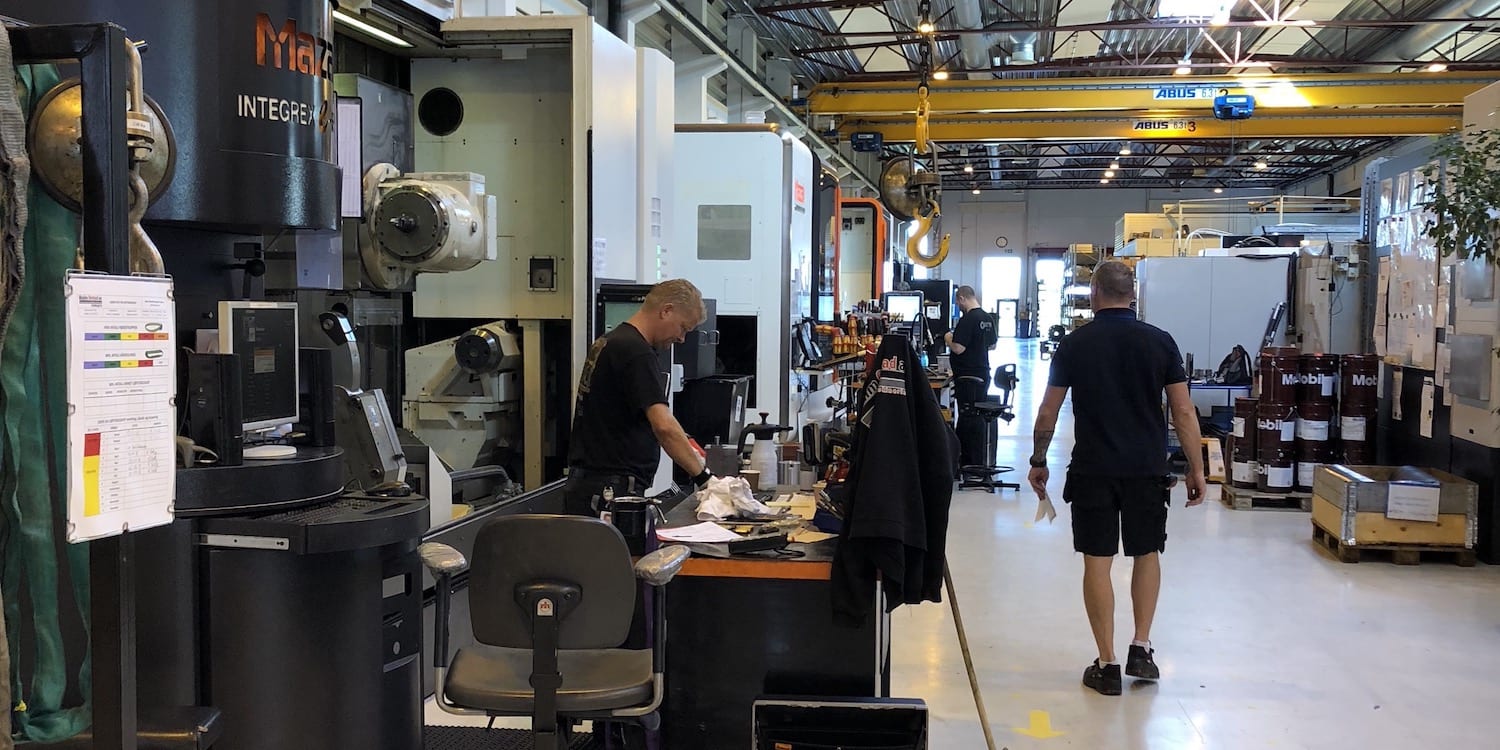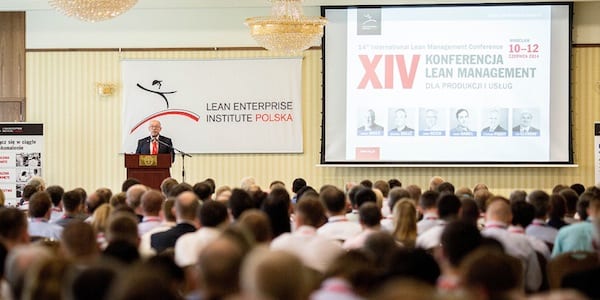
Rising from the ashes thanks to lean thinking
FEATURE – This Norwegian company has come back from the brink of bankruptcy by rallying its people around a common set of values, by leaning out its processes and by involving its leadership team.
Words: Eivind Reke, Organizational Secretary, LOS Norge
We normally think of lean as a growth strategy, but what happens when a lean leader takes over a company operating in a rapidly contracting market? Can lean thinking fulfil its promise of creating a learning environment when a company needs to save itself from going bust? This was the challenge that Lauritz Haringstad Løvø faced when he accepted a job offer from Malm Orstad in 2015.
Malm Orstad is a small sized family-owned business situated in the oil region of Norway, near Stavanger. It was founded in 1946 by the Orstad family and up until 2008 it was a small and naturally flexible company where everyone pulled together and did what had to be done to deliver high-quality machining products. From 2009 to 2013, the company surfed a growth wave fuelled by the oil industry in nearby Stavanger (the oil capital of Norway) – a seemingly unstoppable upward trajectory. In 2014, however, things started to change. The market began to slow down, until it completely dried out. This caused a drop in turnover from a record 285 million NOK in 2013 to a record deficit of 30 million NOK in 2015 and 2016.
After the market crashed, the owners of the company turned to Lauritz for help. He had one condition: that the management team give full support to the lean turnaround of the company. Lauritz was well known in the area from his previous lean endeavours in other local companies. However, in previous leadership jobs, he felt that he had not been able to use lean to its full potential and create a true lean thinking organization. Having previously struggled to bring lean outside of manufacturing, he saw this as a challenge and an opportunity to put his thinking into practice and create a true lean enterprise.
When he joined Malm Orstad just after the summer of 2015, he found a company that had outgrown its start-up roots. With each employee and manager working with their own set of standards, it was an organization in dire need of structure, but also a learning system. The then CEO Magne Orstad with CTO and COO Bjørnar Huru at the helm, saw that something had to change but could not see what. They had talked about lean for a number of years as a possible solution but had stopped short of actually trying it. With a clear mandate to do whatever it took, Lauritz made sure that Malm Orstad would walk the talk.
CREATING A SHARED VISION

The first step for Lauritz was to create a sense of purpose for the company. Upon joining, he found that, to his surprise, the firm didn't really have a shared vision to work towards - only some arbitrary financial goals and a few growth targets. Lauritz had to quickly find and face the problems the company was experiencing that had previously remained untouched, while at the same time teaching his new leadership team (including the CTO Bjørnar Huru and the production manager Morten Orstad) lean thinking through practical experiments on the gemba. There was no time for classroom exercises, nor money for external consultants. Lauritz knew that the turn-around of Malm Orstad could not be outsourced. He would have to lead it himself, and quickly get the rest of his leadership team onboard.
After two years of heavy losses, Malm Orstad was suffering and bankruptcy loomed. Lauritz felt he needed to rally the organization around a common set of values and a shared goal in order to successfully address the issues at hand. So, that's the first thing the leadership team did. Lauritz gathered his team for a weekend workshop to define what values best represented the company and support their goal of becoming a learning organization with happy customers. (They came up with willingness to learn, responsiveness, loyalty and teamwork.) In fact, the board also made a resolution to use lean thinking as the strategy to achieve this goal, and every manager developed their own personal A3 on how they would support the lean transformation.
To Morten, a production manager with a hands-on attitude, this felt a bit too “academic”. Surely, more concrete action was needed in desperate times such as these, he said in more than one occasion. However, he soon realized how the values and the vision would serve as a guide for his own leadership and a foundation for challenging and supporting his team in the factory. What he didn't know was that, in this process, his way of acting and seeing himself as a leader would also change.
Indeed, the common values helped create a culture of honesty that over time would allow the company to continuously find and face its problems on the shop floor, in project management, in sales and in purchasing. (Lauritz knew that bringing lean to manufacturing only isn’t enough, and that enabling communication and collaboration among departments is essential to achieve sustainable results).
Once different areas of the business were engaged in rebuilding Malm Orstad from the ground up, Lauritz could now count on the support of the whole organization to shape a new way of working. Daily meetings and visual management in leadership teams, in engineering projects and in purchasing further foster this culture of transparency. A number of cross-functional problem solving A3s has also been developed based on issues identified both in production and in engineering.
LEAN MANAGEMENT: A NEW WAY OF WORKING
While it was good to have the leadership team undertake this learning journey, no meaningful change would ever appear without involving all of the employees in continuous improvement. To get started, Lauritz used classic lean tools such as visual team boards, 5S, value stream maps and problem solving A3s. The idea behind this was to help people to deepen their understanding of their work and to see how it connects with the next step in the value chain and with the whole value stream. However, one of the most important things they did was to really start to develop standard work throughout the organization using checklists, visual work standards etc. This turned out to be critical in creating stability in the organization.
Most impactful was perhaps the introduction of visual management and daily meetings, a reflection of two fundamental leadership mantras in which Lauritz believes: 'problems first' and 'brutal honesty'. Together, these started to change the way leaders and employees viewed their work. Even though they found it difficult at first, Bjørnar, Morten and the rest of the leadership team could not hide from the honest picture provided by visual boards and the meetings taking place by them. Arguing with data is just not possible.
Transparency, which the boards mandate, can only exist if management practices it first. That's why the leadership team now gives employees full access to information, from sales forecasts to financial performance, from KPIs to the overall strategy of the business. Critically, they also include the union representatives and consult with them on how information should be shared with the rest of the company, to avoid misunderstandings. Leaders have also learned to celebrate people's wins: at every meeting, they present examples of improvements carried out by front-line staff, explaining how it impacted the company in terms of quality, delivery, safety or cost.
This culture of openness and transparency also encourages people to solve their cross-functional problems together. This isn’t easy and arguments still occur, but the benefits of a more horizontal way of working are clear: in two years, the company has reduced the cost of goods from 60% of turnover to 28%. This was achieved by reducing the amount of scrap by solving quality problems, cutting the number of sub-suppliers and forming long-term partnerships with the remaining sub-suppliers. Now it is a matter of continuing along the same path, always finding new problems, solving them and learning together.
As with most lean transformations, not everyone in the company was onboard from day 1. Improvement, however, has the power to turn Lean's harshest critics into its staunchest supporters. At Malm Orstad, one such example was an experienced industrial mechanic, who had been strongly opposing the development of visual work standards. One day, the man had trouble re-starting the air compressor that supplies the workshop with compressed air. After many failed attempts, he found a visual standard hanging behind the door, followed it and managed to restart the machine. He promptly went down to the workshop to tell everyone about his experience, which turned him into a key contributor to the standardization and improvement efforts in the workshop. Talk about a-ha moments!
By bringing together the company through the development of a shared vision, challenging everyone to live by those values every day, and by thinking more deeply about their quality, HSE and delivery issues, the team at Malm Orstad managed to move the company from near-bankruptcy to profitability. More importantly, the journey has transformed the way of thinking of managers and employees at Malm Orstad. It looks like that old saying ‘Good thinking, good products' is true in Norway as much as it is in Japan.
THE AUTHOR

Read more


FEATURE – Hospitals are often part of larger healthcare systems, which makes it critical to learn how to bring lean to such diverse and complex environments. We hear from a large hospital group in Ireland.


FEATURE – The restaurant business has always been tough, but Covid-19 is now presenting it with new challenges. The author shares a few lean practices that can help restaurants develop competitiveness.


REVIEW - Roberto Priolo reviews the 14th Lean Management Conference, held earlier this month in Poland. With great presentations and speakers, the event left him with a lot to reflect on.


RESEARCH – Every advocate of lean with a skeptical boss has been asked “What’s the ROI of lean?” at least once. This landmark article explains that lean can indeed help us to achieve a superior ROI, so long as we view it as an all-encompassing strategy rather than a simple tactic.

